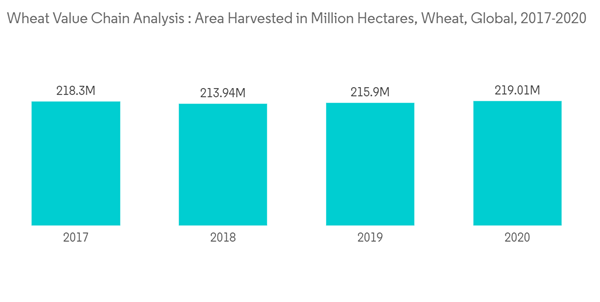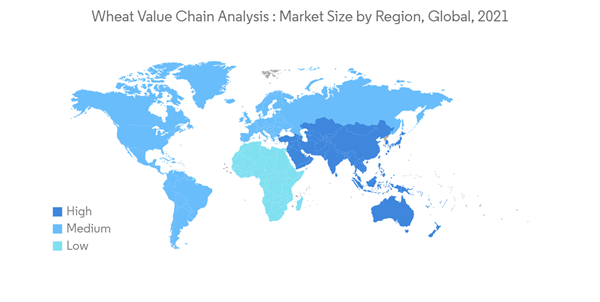The wheat market is much more dispersed than other grain markets, and the countries of the former Soviet Union represent a relatively small share of that market. Hence, the wheat trade restrictions result in a 4% increase in global prices. Wheat has seen a minimal direct impact from the outbreak of COVID-19 across the world. Being an essential food alongside its staple by-products, flour and bread, any change to prices minimally affects the demand.
Wheat is one of the key global commodities in terms of acreage and tradeable value and is a staple in household diets. Many factors affect wheat prices, including climate, yields, oil prices, lagged prices, and imports. In addition to gradually and consistently increasing global wheat demand, these market drivers are posited to impact world prices and, ultimately, food security. Approximately 21% of the world’s food depends on annual wheat crop harvests, which often have relatively low stocks. The developing countries, the majority of which are net wheat importers, consume 77% of the total global wheat production. Accordingly, wheat accounts for approximately 24% of food commodities imported by developing countries.
Countries like the United States, Canada, Australia, China, France, and Russia are the major players involved in intense wheat trade activities across the world. Hence, over the long term, the increased food security focus and trade initiatives, along with increased participation of the major producing countries, are anticipated to drive the growth of the wheat market during the forecast period.
Key Market Trends
Increasing Area Under Wheat Production Across the World
Wheat is one of the principal cereal grains produced and consumed globally. It is grown on more land area than any other commercial crop and continues to be the most important grain food source for human consumption. This is likely due to the fact that wheat can be cultivated in many areas with heterogeneous types of weather, elevation, or soil. According to the Food and Agriculture Organization, the global wheat production in 2020 accounted for 760 million metric ton, and the global area harvested under wheat in 2020 accounted for 219 million hectares. Accordingly, Asian countries like China, India, and Australia, European countries like Russia, France, and Germany, and North American countries like the United States and Canada are the major producers of wheat globally. Despite the increase in wheat production over the past few decades, developing countries have continued to import two-thirds of all the world's wheat trade flows, owing to the increased domestic demand. However, the demand for wheat has been relatively high and stable in North Africa and the Middle East, South Asia, East and Southeast Asia, South America, and Sub-Saharan Africa. Hence, the increased domestic and international demand for wheat, along with increased consumption and increasing area under wheat production, is anticipated to drive the market studied during the forecast period.
Asia-Pacific is Leading the Growth of the Market
In Asia-Pacific countries like India and China, wheat production has seen an increasing trend over the last few years. For instance, in China, wheat production increased from 131.4 million metric ton in 2018 to 134.2 million metric ton in 2020. Similarly, in India, wheat production increased from 99.8 million metric ton in 2018 to 107.5 million metric ton in 2020. In India, the growth of the wheat market is driven by the major progressive policies implemented by the government. These include a significant increase in minimum support price (MSP) and government procurement. Wheat production in China has significantly increased due to the favorable weather conditions, input availability among farmers, and increased investment from the government to boost the production in terms of research and technology. Thus, the favorable climatic conditions and government policies are boosting the growth of the market in the region.
Additional Benefits:
- The market estimate (ME) sheet in Excel format
- 3 months of analyst support
This product will be delivered within 2 business days.










